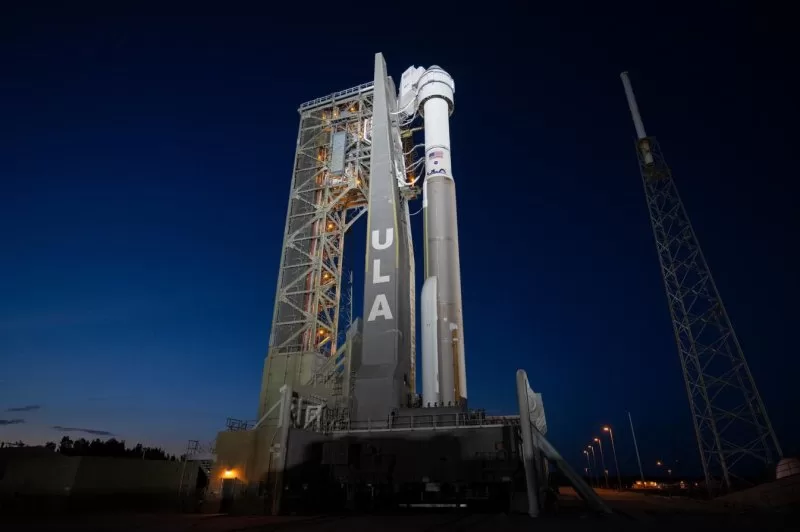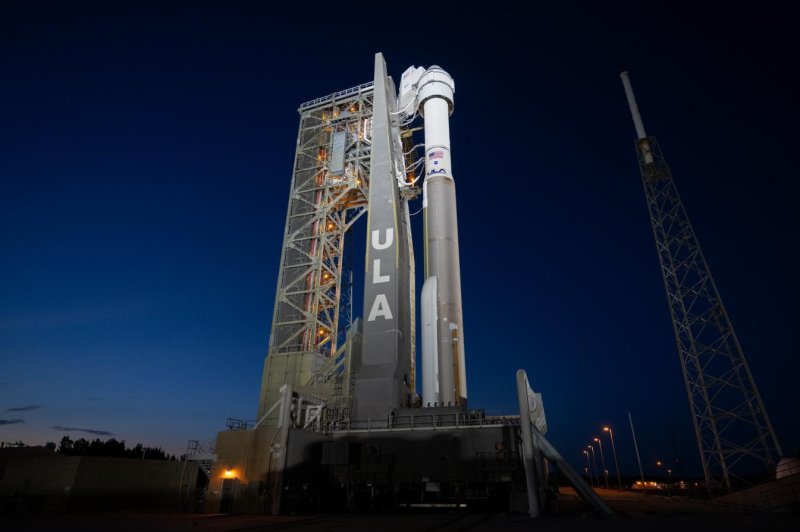1 of 3 | The first crewed mission of Boeing’s Starliner capsule was scrubbed Monday night, with two astronauts on board and just hours before launch, over concerns about an oxygen relief valve. The United Launch Alliance Atlas V rocket launch with Boeing’s CST-100 Starliner spacecraft aboard on the launch pad at Space Launch Complex 41 of Cape Canaveral Space Force Station in Florida will be rescheduled. Handout photo by NASA/Joel Kowsky/EPA-EFE
May 6 (UPI) — The first crewed mission of Boeing’s Starliner capsule was scrubbed Monday night two hours before launch over concerns about an oxygen relief valve. The launch was canceled “over an abundance of caution” after the two astronauts had been strapped inside the capsule atop the Atlas V rocket.
“ULA Launch Director Tom Heter III has made the decision to the launch team that launch operations will not continue tonight for Atlas V and Starliner,” United Launch Alliance wrote Monday in a post on X at 8:34 p.m. EDT.
“Today’s Starliner launch is scrubbed as teams evaluate an oxygen relief valve on the Centaur Stage on the Atlas V. Our astronauts have exited Starliner and will return to crew quarters,” NASA announced Monday night in a post on X.
Boeing’s long-delayed first crewed Starliner mission was scheduled to launch at 10:34 p.m. EDT from Cape Canaveral Space Force Station in Florida, for a 10-day test flight to certify the spacecraft for future manned missions.
Astronauts Suni Williams, 58, and Butch Wilmore, 61, were already strapped into the Starliner capsule, when the launch was called off. The Starliner was scheduled to travel to the International Space Station and back to Earth.
Earlier, with just hours to go before the scrubbed launch, Williams and Wilmore exited NASA’s Operations and Checkout Building at 7:16 p.m. EDT for their ride to Space Launch Complex-41, as friends, family and colleagues gathered outside to celebrate their send-off.
After arriving at the launchpad in the Starliner Astrovan, Wilmore boarded the spacecraft for the long process of being strapped in, followed by Williams, as they underwent “a series of checks, including umbilical hook ups, communications checks and suit checks,” Boeing Space wrote in a post on X, that showed the astronauts inside the spacecraft.
While there has been no announcement at this time about rescheduling the launch for Starliner’s test flight, controllers could make a second attempt to launch Tuesday night. There are also launch opportunities on Friday and Saturday, as NASA, Boeing and ULA emphasized at a news conference after the scrub that they are in “no rush to fly.”
“We’ll take the next day or so to look at the data and to recommend the next course of action and then we’ll take the next steps and fly when we’re ready,” Steve Stich, NASA’s Commercial Crew Program manager told reporters Monday night, adding that up until the scrub everything during the countdown had been going well.
“Overall, things were going really well when the team noticed a valve had a bit of a buzz,” Stich said.
The buzz turned out to be a mechanical valve that vents gas, which “every now and then will flutter or buzz,” according to Tory Bruno, chief executive officer of ULA.
While Bruno said cycling the valve has already stopped the problem, he said flight rules do not allow that process to be performed when there is a crew on board the spacecraft.
“You do not change the fueled state of the vehicle when the crew is present,” Bruno said. “We don’t have an instrument on the valve to tell us how much it opened. The blue team could hear the valve buzzing. And it didn’t stop. That is what triggered the team to make the scrub.”
In the next few days or week, if and when Starliner launches, the capsule will break away from the Atlas V rocket within the first 24 hours and fire its own engines to travel to the space station.
“They’re checking out a lot of the systems: the life support, the manual control,” NASA Administrator Bill Nelson told reporters Friday. “That’s why we put two test pilots on board — and of course the resumés of Butch and Suni are extensive.”
Wilmore and Williams, who are U.S. Navy-trained test pilots and helped develop the Starliner capsule, will use the mission to make sure all systems on board work as planned in order to certify the spacecraft for future manned missions.
“This has been a developmental process where we’ve been involved and ensconced in that process,” Wilmore said during a virtual news conference Wednesday.
“All the way from hardware and software evaluations in the simulator, we’ve got our fingerprints on every single procedure in this process,” he added. “That’s what the test process is.”
Despite Monday’s scrubbed launch, the Starliner’s first manned mission is already four years behind schedule after a test mission in 2019 failed to reach the International Space Station. The unmanned 2019 test flight suffered a series of software and hardware failures, but managed to land at the White Sands Missile Range in New Mexico. Boeing engineers made more than 80 adjustments after identifying what caused the first mission to fail.
In 2022, Starliner successfully reached orbit, docked at the space station and returned six days later.
NASA has spent $4.2 billion to design and build Starliner, with Boeing spending another $1.5 billion while developing it. The spacecraft can carry up to four astronauts to low-Earth orbit where they can use manual or automatic steering to maneuver it. The Starliner capsule is designed to be used for up to 10 missions.
“Our mission is primarily a test mission to check out flying the spacecraft to the space station, docking and then checking it out while it’s docked to ensure it can be a safe haven that can remain docked for a number of months,” Williams said, adding that the goal is to ensure successful missions in the future with Starliner designed to spend up to seven months docked at the International Space Station.
“This is our opportunity to lay that groundwork, so in the future, we hope people won’t ask why we did it one way or another,” she said. “We want to make it as best as possible for future missions. We are the ones working with the engineering team to make all of that happen.”
Both Wilmore and Williams have already spent six months on the International Space Station, using space shuttle and Soyuz missions to get to the orbiting space laboratory.
Once launched, the astronauts will navigate and test Starliner before docking at the International Space Station. They will return to Earth days later in the same capsule, which will parachute down to a landing in the southwestern United States.

